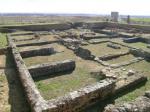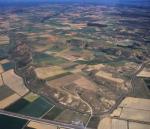Summary (English)
Research (2000-2013)
Lancia, the most important Asturian town, is considered their capital by some authors, although there is no actual record of a town as the administrative center, nor there was any evidence of it. It is 14 km away from León and 1 km far from Mansilla de las Mulas.
The epithets used to refer to it, validissima civitas (Florus), or “the most important Asturian town” (Cassius Dió ), seem to be confirmed by the archeological findings dating to pre-Roman times. According to present information, this Second Iron Age permanent settlement would have covered an approximate area of 30 ha. This phase is represented in the archeological site by the remains of dwelling floors, built using poles fixed to the ground, hearths, domestic ovens, as well as some remains of adobe buildings, all of them dating to the 2nd and 1st centuries BC.
Partial sections carried out on the floor of the Roman baths revealed other evidence for the pre-Roman phase. In chamber IV, for example, an ash-colored lens supplied Celtiberian pottery and a deer antler handle. Moreover, remains of flooring are preserved in chamber I. Dark lenses were documented to the south, in the court subsequently occupied by the palaestra, as well as in the section carried out in the corridor of the thermae. Under a circulation area there, dated to the construction phase of the thermae, a floor containing a small silo was observed, as well as a pot filled with charcoal, which had a clay lid with a reddened surface, due to heat.
In the year 25 BC Publius Carisius attacked and captured the town and spared it from destruction by his soldiers so that “it could be a better monument to Roman victory if left unburned” (ut cum in captam urbem faces poscerentur aegre dux impetrauerit ueniam ut uictoriae Romanae stans potius esset quem incensa monumentum).
The buildings that best represent the Asturian-Roman phase are the thermae located in the center of the town, as well as those located in the peripheral area called “Valdealbura”. Of the latter thermae, there are only two partially known rooms: one heated, the other one not. The first thermae, in the center of town, medium-sized and functional, have adjoining changing rooms, cold bath and hot bath chambers, as well as other spaces for physical exercise, and latrines. In its final use phase the building was divided in two different areas, probably in order to be simultaneously used by men and women. Continuous reuse of building materials is the reason for its poorly preserved condition.
The macellum has three sections: an entrance area leading to a cardo of the town (probably the cardo maximus). The second section concentrates the shops (six in total) and a back yard. The backyard was probably used as a farmyard where the animals, which would later be slaughtered and sold in the market, were kept.
The Roman town, reconstructed during the 1st century, was permanently abandoned in the 4th century. Or at least the center was, although it is possible that peripheral areas of the city kept some population, as the existence of loose materials out of stratigraphic context reveals.
(translation by Laura González Fernández)
- Jesús Celís Sánchez y Jesús Liz Guiral
Director
- Jesús Celis Sánchez (Instituto Leones de Cultura de la Diputación de León)
- Jesús Liz Guiral (Universidad de Salamanca)
Team
Research Body
- Instituto Leonés de Cultura
- Universidad de Salamanca
Funding Body
- Diputación de León






![Download [PDF]](/excavation/skins/fasti/images/results/download_sml.png)

